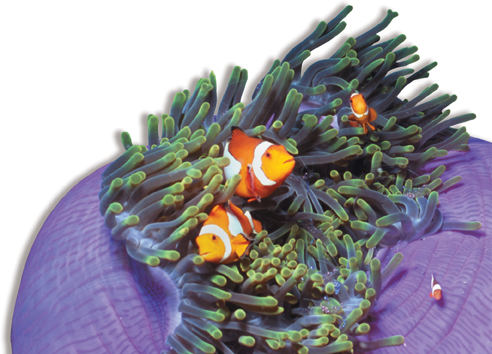Keystone Species Sometimes changes in the population of a single species, often called a keystone species, can cause dramatic changes in the structure of a community. In the cold waters off the Pacific coast of North America, for example, sea otters devour large quantities of sea urchins. Urchins, in turn, are herbivores. Their favorite food is kelp, giant algae that grow in undersea “forests.”
A century ago, sea otters were nearly eliminated by hunting. Unexpectedly, the kelp forest nearly vanished. What happened? Without otters as predators, the sea urchin population skyrocketed. Armies of urchins devoured kelp down to bare rock. Without kelp to provide habitat, many other animals, including seabirds, disappeared. Clearly, otters were a keystone species in this community. After otters were protected as an endangered species, their population began to recover. As otters returned, the urchin populations dropped, and kelp forests began to thrive again. Recently, however, the otter population has been falling again, and no one knows why.
 In Your Notebook Not all keystone-species effects are due to predation. Describe the dramatic effects that the dam-building activities of beavers, a keystone species, might have on other types of organisms.
In Your Notebook Not all keystone-species effects are due to predation. Describe the dramatic effects that the dam-building activities of beavers, a keystone species, might have on other types of organisms.
MYSTERY CLUE 
One of the favorite prey species of the wolves in Yellowstone is elk. How do you think this relationship could affect the ability of certain plants to grow in Yellowstone?
Symbioses
 What are the three primary ways that organisms depend on each other?
What are the three primary ways that organisms depend on each other?
Any relationship in which two species live closely together is called symbiosis (sim by OH sis), which means “living together.”  Biologists recognize three main classes of symbiotic relationships in nature: mutualism, parasitism, and commensalism.
Biologists recognize three main classes of symbiotic relationships in nature: mutualism, parasitism, and commensalism.
Mutualism The sea anemone's sting has two functions: to capture prey and to protect the anemone from predators. Even so, certain fish manage to snack on anemone tentacles. The clownfish, however, is immune to anemone stings. When threatened by a predator, clownfish seek shelter by snuggling deep into tentacles that would be deadly to most other fish, as seen in Figure 4–9. But if an anemone-eating species tries to attack their living home, the spunky clownfish dart out and fiercely chase away fish many times their size. This kind of relationship between species in which both benefit is known as mutualism.

FIGURE 4–9 Mutualism Clownfish live among the sea anemone's tentacles and protect the sea anemone by chasing away would-be attackers. The sea anemone, in turn, protects the clownfish from their predators. Infer What could happen to the sea anemone if the clownfish died?
Table of Contents
- Formulas and Equations
- Applying Formulas and Equations
- Mean, Median, and Mode
- Estimation
- Using Measurements in Calculations
- Effects of Measurement Errors
- Accuracy
- Precision
- Comparing Accuracy and Precision
- Significant Figures
- Calculating With Significant Figures
- Scientific Notation
- Calculating With Scientific Notation
- Dimensional Analysis
- Applying Dimensional Analysis




